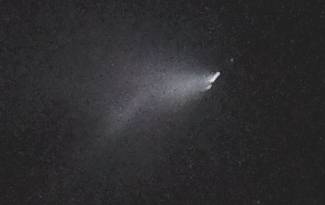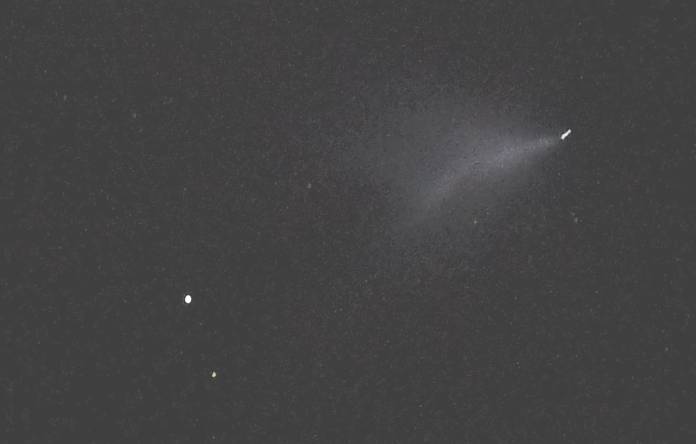An UFO (No, it's Fengyun 2F
!) in the night
sky...
Just to avoid any
misunderstandings: I do not believe that the sky is populated by flying
saucers piloted by little green men having antennas instead of ears,
and I also don't believe that we are being invaded by spaceships "from
other dimensions", or anything like that. But occasionally I do see
something interesting in the sky, and I'm puzzled what it is. As long
as its true and certain nature is unknown to me, and if with some
stretch of phantasy
it can be considered to be flying, it is an Unknown Flying Object, by
definition!
So here is one.
When I was about to
close the curtain to go to bed on the evening of january 12th, 2012, I
happened to see a strange thing in the sky. It looked a bit like a
comet, but the tail seemed much wider - and in the wrong direction! So
I ran for my camera and tripod, and started shooting pictures. This is
the first:
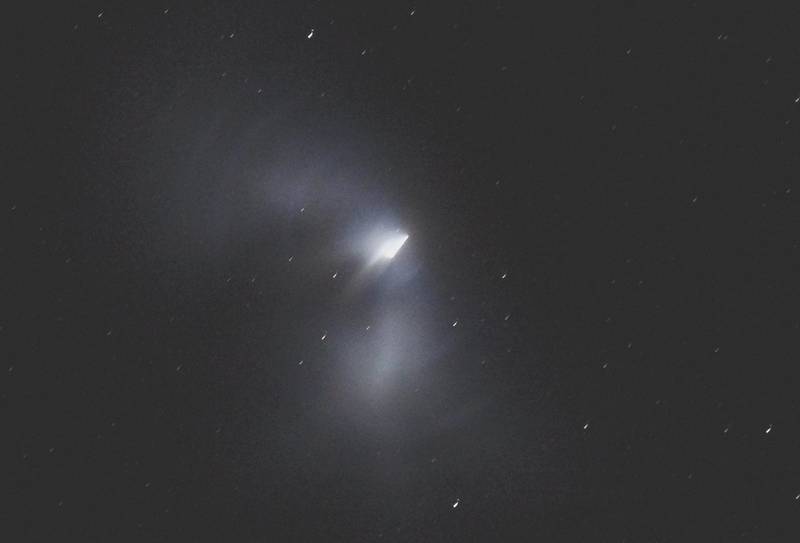
I'm located at roughly 39 degrees south, 72 degrees west. From this
viewpoint the object was roughly at an azimuth of 310 degrees,
elevation of roughly 45 degrees, but I didn't measure those, they are
just estimations. In UTC, it was 2012-JAN-13, 01:52. That was a little
less than 2 hours after my local sunset.
The lens used for all these images has a focal length of
180mm, and the camera has an APS-C sensor of 12MP. All images on this
page are crops of the full frames. The exposure time of this photo was
4 seconds, so you can calculate the angular dimensions and speed from
the
elongation of the stars and the object nucleus. Note that the object
has an apparent motion
several times as fast as the stars, and in almost exactly the opposite
direction.
The object looks a bit like a comet: A bright nucleus, with a fainter
but very visible tail. But it moves far too fast to be a comet, and its
tail seems to point approximately toward the sun, not away from it. On
the
other hand, it moves much slower than a satellite in low earth orbit.
So, it looks like this thing is in a higher earth orbit, but still well
below the geostationary level.
My guess at that point was that the object is a new satellite, caught
in the act of using its rocket engine to move from a provisional low
orbit upward to its definitive orbit! Judging from where it appeared in
the sky, it could have been roughly in an equatorial orbit,
moving west to east. That's consistent with a satellite
intended to end up in geostationary orbit.
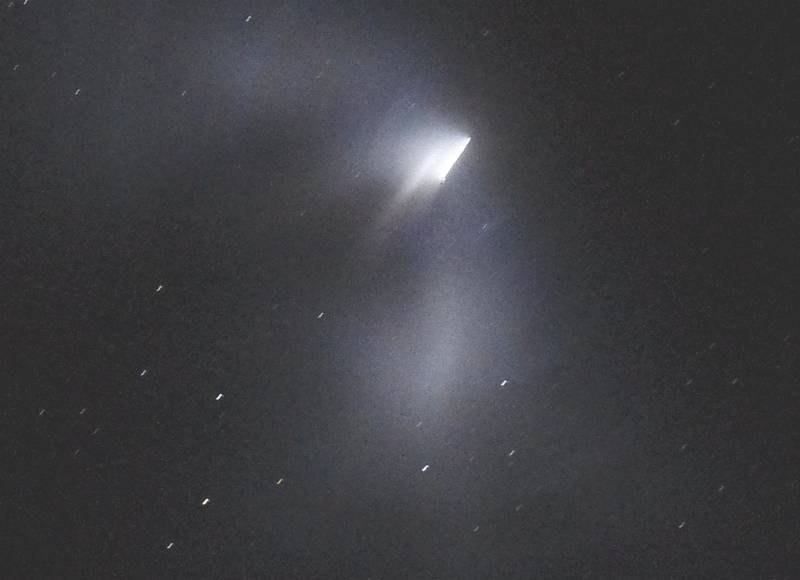
16 seconds later, and seen in a smaller crop. The exposure time is 4
seconds again. Compare to the previos image, to see how the object
moved, relative to the stars. It's interesting to see the cloudlike
blobs. These don't seem to be artifacts of the camera or lens. I
couldn't get any such ghostlike things from any other bright objects.
So they seem to be real. Could it be that such a satellite uses several
big thrusters pointing in significantly different directions? I don't
think so, because that would be wasteful of fuel. So I don't
have a good explanation what these clouds are.
Just because it was so nice, here is another version of that exact same
photo, but now without any downsizing. So here you get the full
resolution of the camera, pixel by pixel. It's a little grainy, because
I was using ISO 3200:
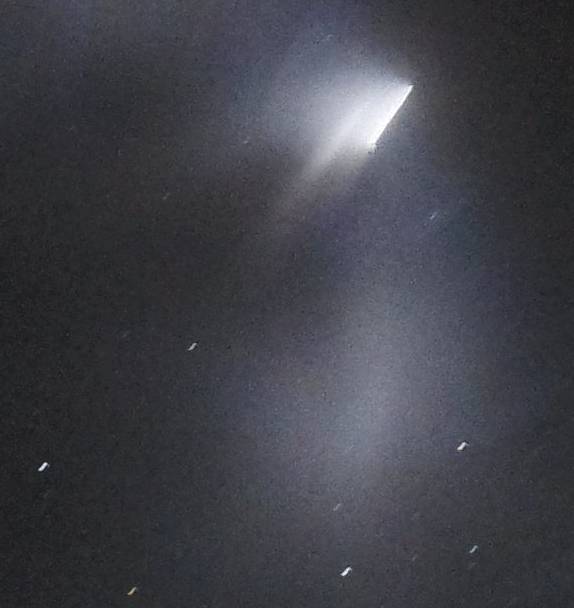
I then switched to 1
second exposure time, to avoid stretching out things so much. Here is a
picture taken more than 4 minutes after the previous one. It also has
the full pixel resolution. Note that the nucleus apparently has become
far shorter, due to shorter exposure time. But it also seems to be
getting much weaker, and it has shrunken more than by a factor of 4! So
it's clear that it's moving away from me. It was also moving "up" in
the sky, getting closer to my zenith, still in a mainly northwest
azimuth.
It's interesting to notice that there seems to be a second, smaller
object behind it. Maybe that's the plume of a smaller thruster that was
being pulsed to make course corrections?
I would also like to understand why the main plume seems to be at an
angle of about 45 degrees to the direction of travel!
This picture was shot about 9 minutes after the first picture on this
page. By the way, the timestamps provided by the camera in the EXIF
data of the JPG files on this page are in my local summer
time, and are early by
about 11 minutes, because the clock of my camera likes to run away into
the future...
Now the plume seems to be a bit better aligned with the direction of
motion, but still not as straight as it should! The object is also
becoming quite faint. It was already hard to see with the naked eye.
And the last photo, taken roughly 11 minutes after the first
one. Also at 1 second exposure time, and full pixel resolution. The
object was now roughly 70 degrees high in my sky, and I was getting
into trouble seeing it, because I was shooting through a
window (it was open, of course!!!), and the overhanging roof was about
to block the object.
Well, that's it. Can anybody out there tell me with certainty what
exactly it was?
Update!!!
About 12 hours
after shooting these photos, and a few hours after setting up this web
page, information came in. The UFO has turned into an IOO: An
Identified Orbiting Object! It's the launch rocket's upper stage of the
FengYun 2F satellite.
This new weather
satellite was launched from China at 00:56, into a
geostationary transfer orbit. That's a highly elliptical orbit, with an
apogee roughly at the geostationary orbit altitude, but a very low
perigee of only a few hundred km. According to the information I got,
the Long March rocket burned for about 20 minutes to place the
satellite in this orbit, so the burn should have ended almost half an
hour before my first photo.
According to the
first set of orbital data available, when I shot the first photo the
object was at an azimuth of 294 degrees, and an elevation of 42 degrees
from my place. At the time my last photo was shot, the object was at
311 degrees azimuth and 54 degrees elevation. This agrees roughly with
my (estimated) position data, but specially the elevation of only 54
degrees at the end shows less good agreement with my
observation of the object getting hidden behind the slightly
overhanging roof of my home. I think it was higher. If updated orbital
data become available before the satellite is moved to its final orbit,
I will re-check this. If it still disagrees, I will have to take out a
tape measure and a calculator, and find out at what exact elevation
that overhanging roof starts blocking my view!
What was it,
exactly, what I saw and photographed? Of course, the straight bright
line showing up in the photos is a point-shaped object that's moving
fast, so that it gets elongated due to the long exposure time of 4
seconds (in the first pictures) or 1 second (in the last ones). That
object would probably be the upper stage of the rocket, which must be
roughly 3m in diameter, and perhaps 10m long or so (I'm just guessing).
And surely it's shiny bright, so it's very visible when the observation
conditions regarding sun angle and such are optimal, and they were. And
the small object that's visible too in some photos might be the
satellite, but more likely it's just a star that happened to
be just behind the rocket. Because it should be elongated just as much
as the main object, if it really were the sat! The problem is that my
digital camera does who-know-what digital processing, even to the
supposedly raw image, so one can never be very sure that what one sees
on the photo is really what was there. It's not like with good old
fashioned film photography!
The larger
question still remaining is what this large cloud was. Does some of the
exhaust smoke (water vapor, in the case of this hydrogen/oxygen upper
stage) stay in orbit closely behind the rocket? Or was the rocket
jettisoning a surplus of unburnt fuel? I don't
know.
In any case, it
was a nice sight, and I was lucky to notice this UFO IIO in the sky!




